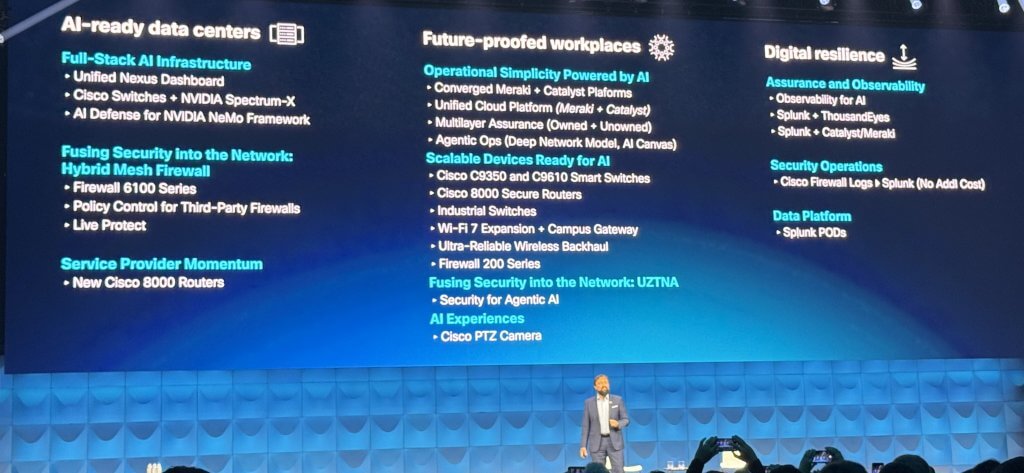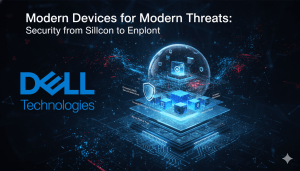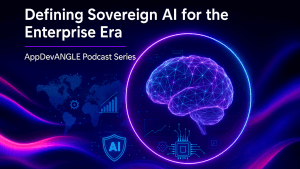In the day one keynote, Cisco CEO Chuck Robbins stated that the Agentic AI transition would be more consequential than the Internet boom of the 1990s. While that is quite a proclamation, Cisco Live 2025 announcements reflected that belief, with President and CPO Jeetu Patel unveiling 24 separate technology launches, yes, 24. (See image below) It included a sweeping set of innovations designed to reshape the enterprise technology landscape for a future defined by AI, automation, and hyper-distributed environments. The announcements signal a clear strategic pivot: from incremental improvements to a full-stack reinvention of how infrastructure, operations, and security must function in the age of “Agentic AI” and “AgenticOps.”

Figure 1. EVP of Global Sales and CSO Oliver Tuszik is highlighting all the announcements
As Figure 1 indicates, the three main focus areas were AI-ready data centers, Future-proofed workspaces, and Digital resilience. Cisco’s unified architecture, “One Cisco,” presents a holistic blueprint for enabling AI at enterprise scale. The combination of AgenticOps (see below), deep networking models (Networking LLM), and scalable, programmable silicon (Silicon ONE) across networking, security, and observability reflects a comprehensive platform approach to drive secure connectivity and operational efficiency.
A New Era of Agentic Operations
One of the most significant announcements centered on Cisco’s AgenticOps model, which Cisco claims goes beyond traditional AIOps by introducing autonomous agents that collaborate with human operators to execute real tasks across various domains. Underpinned by Cisco’s purpose-built Deep Network Model, a domain-specific large language model (LLM) trained on 40 years of networking expertise, they believe AgenticOps represents a foundational shift in how enterprises manage increasingly complex environments.
Rather than relying solely on alert-driven workflows, operators can now engage with a cross-domain AI assistant embedded in Cisco’s new AI Canvas, which combines diagnostics, multiplayer collaboration, and execution in a single, generative UI. This enables teams to collaborate on troubleshooting multi-layer issues—from application-level latency to switch misconfigurations, while maintaining human oversight.
The enterprise impact should be tangible: reduced mean-time-to-resolution (MTTR), improved productivity for NetOps and SecOps teams, and greater agility in responding to network or application anomalies. More importantly, it reflects an architectural commitment to human-centered autonomy, which is critical in environments where trust, explainability, and oversight are essential for accelerating the time to comfort with AI technologies.
AI-Ready Data Centers: Simplifying the Back-End Stack
To support the demands of AI workloads, Cisco introduced a series of enhancements to its Nexus dashboard, Ethernet fabrics, and compute portfolio. The convergence of ACI and EVPN fabric management within the unified Nexus Dashboard provides a single operational model across data center and campus environments, backed by DevOps-ready APIs for pipeline integration.
More significantly, Cisco introduced advanced job-level observability for AI workloads, enabling real-time insight into GPU utilization and network congestion. This granular visibility, integrated with ecosystem partners across storage and compute, helps organizations optimize infrastructure performance and cost in high-density environments.
On the compute side, Cisco added NVIDIA RTX 6000 GPUs to its modular C-Series servers and launched configurable AI Pods, which are validated for enterprise AI workloads. These designs, based on reference architectures and built for horizontal scalability, offer customers flexibility and a faster time to deployment, which is valuable for teams with limited in-house AI infrastructure expertise.
HyperFabric AI, nearing general availability, further simplifies AI infrastructure lifecycle management by enabling the automated deployment, monitoring, and optimization of AI workloads in highly distributed environments.
Future-Proofing the Workplace
Recognizing that the workplace is evolving into a hybrid of human and digital agents, Cisco introduced a new AI-ready, secure network architecture designed to support scale, manageability, and threat defense in distributed environments.
Central to this is the expansion of Cisco’s switch and router portfolio, including Smart Switches built on Silicon One, which offers high performance and inline security. These devices provide microsecond latency, are quantum-ready, and embed policy enforcement directly into the fabric, supporting Cisco’s strategy of security “fused into” rather than “bolted onto” the network.
Cisco also introduced the Wi-Fi 7 access point for high-density environments, such as stadiums, the Campus Gateway for cloud-native wireless management, and new industrial Ethernet devices tailored for robotic and OT use cases. Together, these devices reflect a concerted effort to ensure that every endpoint,from conference rooms to manufacturing floors, can participate in the AI-powered future.
Collaboration hardware announcements, including the Room Vision Pan, Tilt, Zoom (PTZ) camera, and enhanced ceiling microphones, align with this vision, providing an intelligent and seamless communication infrastructure for remote and hybrid teams. As organizations continue to drive back-to-office mandates, these technologies will ensure a better experience and engagement when collaborating.
Embedded Security and Digital Resilience
Security remains a cornerstone of Cisco’s strategy. With the expansion of its hybrid mesh firewall and universal Zero Trust Network Access (ZTNA), Cisco is moving toward intent-based, distributed policy enforcement. Notably, the company now allows policy orchestration across both Cisco and third-party firewalls, a practical acknowledgment of real-world customer environments.
Cisco’s Secure Firewall 200 and 6100 series, embedded with SD-WAN and advanced inspection, support a range of branch and campus scenarios. New capabilities, such as Cisco Live Protect, enable the live patching of vulnerabilities without downtime, a crucial step toward achieving digital resilience.
In Observability and SecOps, Cisco continues to integrate with the Splunk platform to deliver AI-powered insights across application and infrastructure telemetry. Enhanced AI infrastructure observability, LLM monitoring, and integrations with AppDynamics and ThousandEyes enable customers to detect, investigate, and respond to incidents more quickly and with greater business context.
A particularly notable announcement during the event: Cisco will soon offer free firewall log ingestion into Splunk for typical volumes, reducing cost barriers and encouraging broader adoption of data-driven security operations.
Cisco is Leveraging Agentic AI to Transform Customer Experiences
The day two keynote by Liz Centoni highlighted a shift from reactive support to drive personalized, proactive, and predictive services. Her goal is to dramatically reduce configuration errors, streamline operations, and accelerate time to value.
In an example of how Cisco plans to leverage AI, Liz highlighted several key initiatives the team is pursuing, including the deployment of Agentic AI systems to understand customer environments better using both real-time telemetry and historical data to preempt issues and take recommended actions. The team will also utilize adoption agents to tailor onboarding and feature utilization, optimizing business outcomes. Additionally, they will leverage AI-driven automation for Lifecycle activities, combine GenAI and ML for enhanced flexibility, and, most importantly, ensure Human-in-the-Loop (HITL) oversight.
Cisco also launched AI advisory services to help customers identify, prioritize, and implement meaningful use cases. Internally, the company is scaling its training programs to enable its workforce to thrive in an AI-augmented future.
Ultimately, Cisco’s goal is for every customer, regardless of size, to feel uniquely understood and supported, achieving greater simplicity, resilience, and value through trusted AI-powered customer experience (CX).
Customer Feedback
While it is great to witness a significant amount of technical innovation at an event, it is often accompanied by questions about how long it will take to adopt it. In the past, we have seen even incremental technologies take years to be fully embraced. Yet, for AI, the pace of adoption is significantly faster; take, for example, that it took ChatGPT just two months to reach 100 million active users. At a recent event, the head of AI from Microsoft stated that with AI, there will be no fast followers, just organizations that are embracing it and those that are falling behind.
We heard from Cisco customers, including UC San Diego and Ford, about their plans for the AI Era. UCSD’s Dr. Vince Kellen reaffirmed the need to act now, stating, “Agentic AI is here. Start the work. Begin the experimentation.” He noted that his network team needs to leverage AI to become more efficient and automate mundane tasks.
Ford’s CISO, Patrick Milligan, highlighted their decades-long relationship and believes they have built a secure, agile foundation required to scale AI. And while acknowledging that no one has all the answers yet, he believes that Cisco’s roadmap for secure AI infrastructure and cross-domain visibility is aligned with Ford’s requirements to enable what comes next.
Another customer I spoke to during the event was also bullish on the new technology, clearly articulating that AI technology will allow them to focus on more strategic initiatives. It is interesting to note that research from ZK Research and theCUBE Research highlighted that organizations with more mature AI environments (using for 2 years) cited that having additional time to work on strategic initiatives was the top benefit, as compared to those with less than two years of experience, who were more likely to report a faster time to identify and remediate issues as top benefits.
OurANGLE
Cisco’s announcements reflect a coordinated, cross-portfolio platform strategy to help customers meet the architectural demands of a rapidly evolving AI landscape. The sheer volume of announcements indicates a significant cultural shift within the organization. It highlights a focus on innovation and integration. Last fall, CPO and now President, Jeetu Patel, stated, “Next year, we should be a meaningfully different company for the better, and in two years, we should almost be an unrecognizable company for the better, and that would be the yardstick for success.” With 24 technology innovations on display this year, an energized engineering team, and a notably improved vibe at this year’s event, his predictions appear to be coming to fruition.
Key takeaways from Cisco Live 2025 include:
- Agentic-native operations: AgenticOps and Deep Network Models should reduce operational friction and empower smaller teams to manage larger, more complex environments.
- Distributed performance and security: From secure global connectivity to embedded campus security, Cisco is fusing security into the network.
- Platform unification: Unified dashboards, integrated policy control, and AI Canvas promote consistency and multi-player collaboration across NetOps, SecOps, and DevOps. This will drive greater operational efficiencies and mitigate risk
- Open ecosystem alignment: Validated reference architectures, third-party integrations, and programmable APIs offer customers choice and flexibility.
As AI adoption continues to accelerate, infrastructure must evolve beyond point solutions. Cisco’s 2025 strategy presents a cohesive architecture and platform to deliver integrated, intelligent, and secure solutions to help enterprises harness the power of AI while maintaining trust, performance, and agility.
Now that the exciting part, the announcements, is over, it will be time for Cisco to execute and ensure these new solutions are delivered to their customer base on schedule. While the improved pace of innovation is undoubtedly impressive, the actual value will be determined by the business outcomes they can deliver in enterprise and service provider environments. I am looking forward to tracking their progress over the next six to nine months to learn about how customers are adopting and benefiting from these solutions.
For more Cisco Live 2025 coverage from theCUBE Research, please see Dave Vallente’s Breaking Analysis



